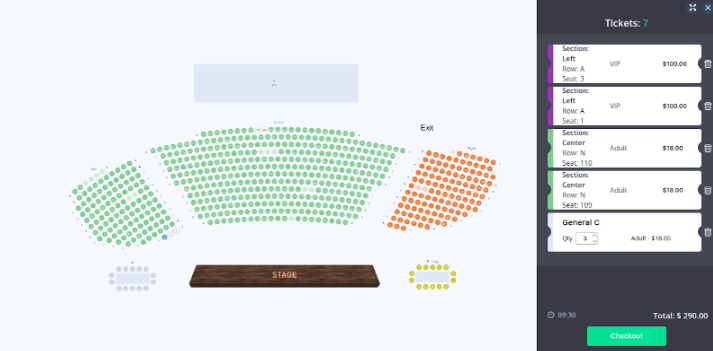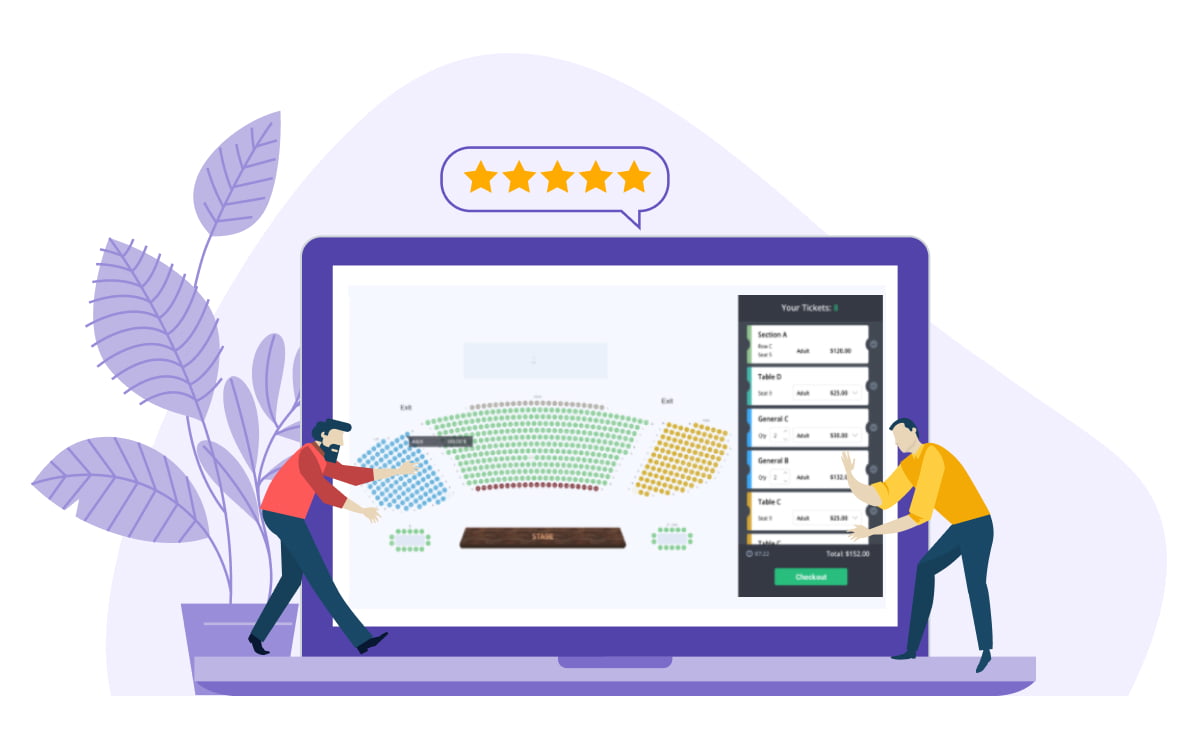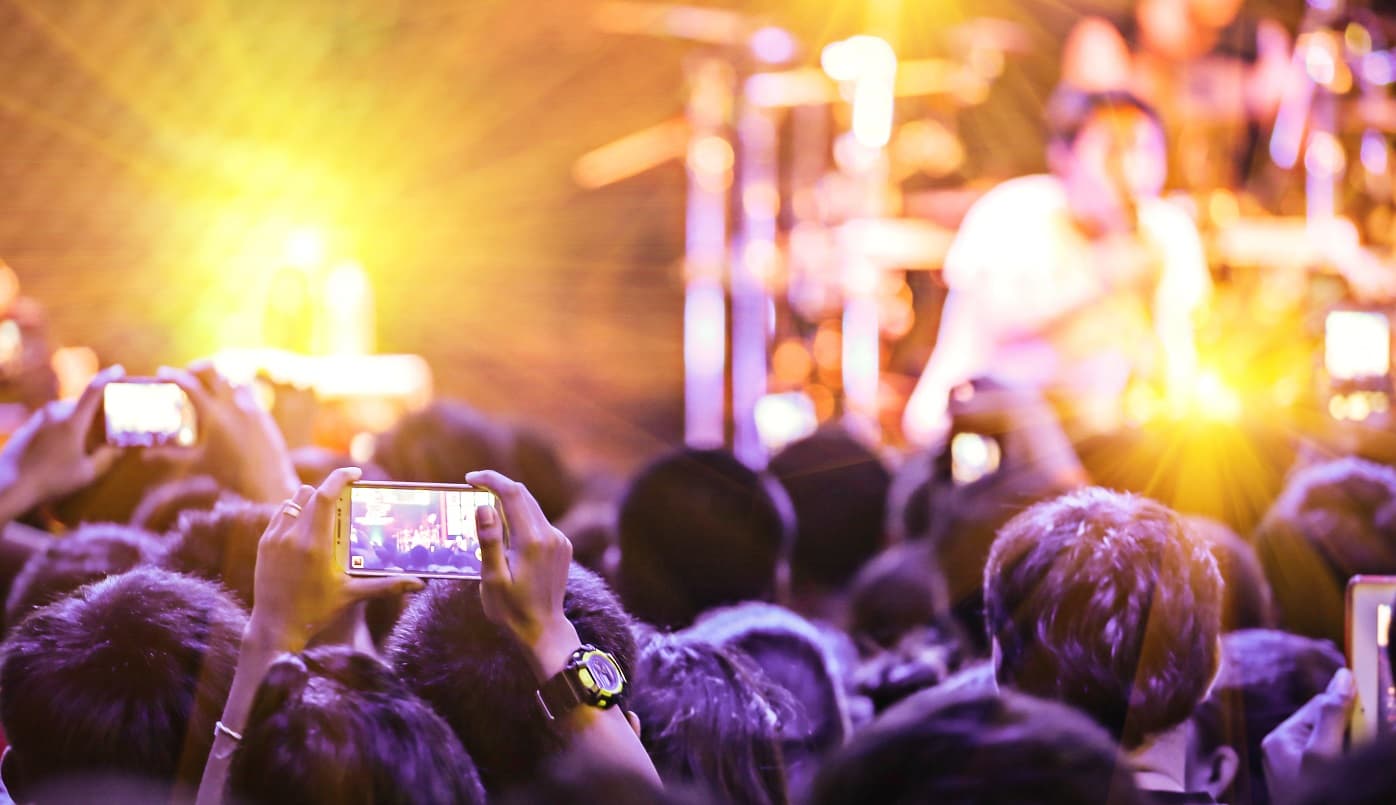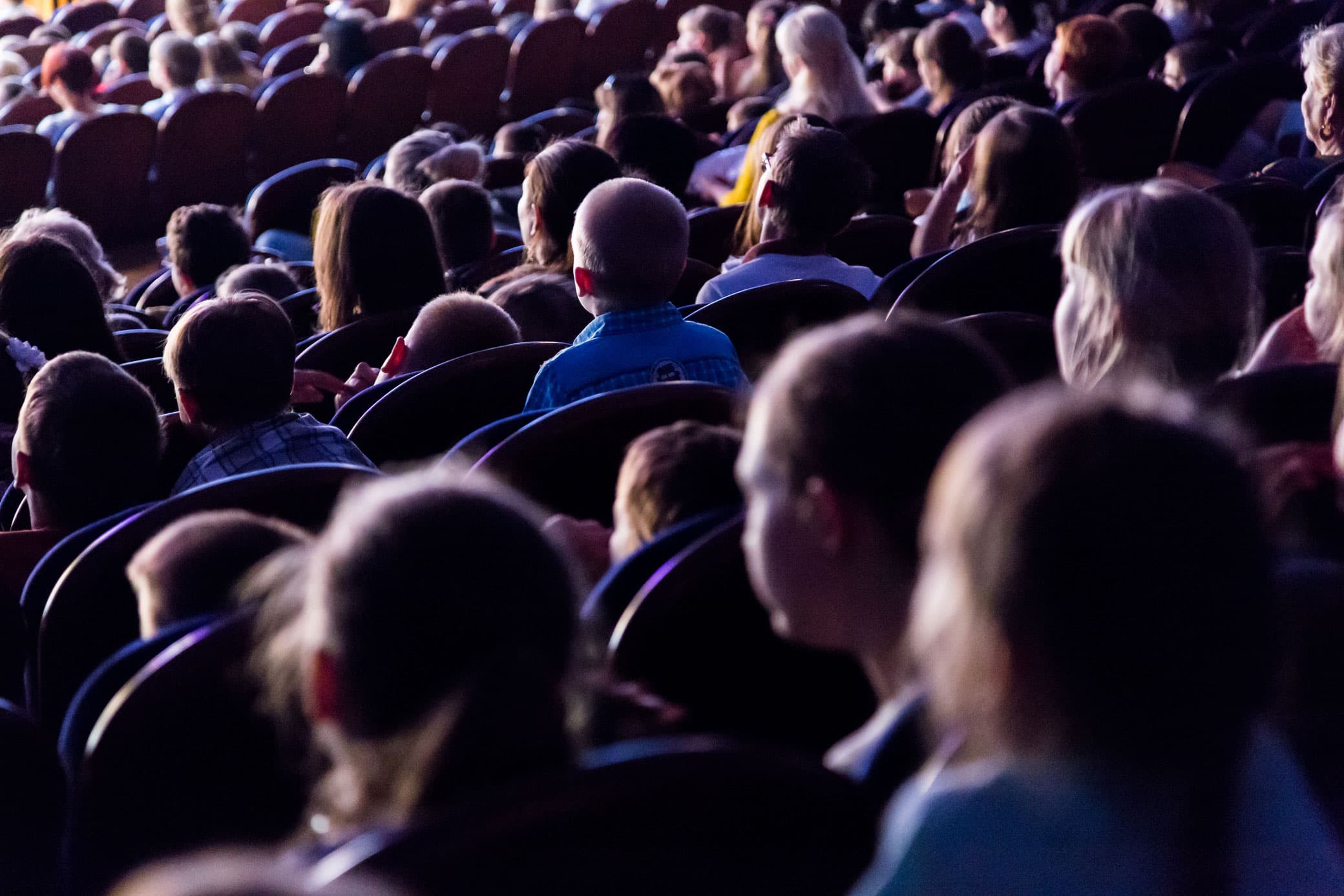If you're planning a live event – no matter the size, venue type, or nature of the event – you'll want to feel confident about your seating plan. Making a well-informed decision about the number and placement of seats will ensure the best possible experience for your audience.
General admission and reserved tickets are the most common ticket types in the industry and are likely the ticket type you will choose between for any live event.
Reserved tickets are a popular choice for attendees who would like the best view or who want to sit in a group, while general admission tickets are often preferred for those who like to move around at an event.
According to a market research study published by Custom Market Insights, the demand analysis of Global Live Music Market size & share revenue was valued at approximately USD 34.84 Billion in 2024 and is expected to reach USD 38.58 Billion in 2025 and is expected to reach around USD 62.59 Billion by 2034, at a CAGR of 8.78% between 2025 and 2034. Event organizers who understand their audience's seating needs are positioned to capture this growth.
Over the last twenty years, we've gained deep insights into seating and meeting audience preferences. We are ready to share the most essential information to help you make informed decisions about seating for your next event.
General Admission: Something for Everyone
What Does "General Admission" Mean?
General admission (GA) is a type of ticket that allows a person entry to an event but does not guarantee a specific seat assignment.
With a general admission ticket, you may be given a specific area to sit or stand in, but you won't have a specific seat reserved for you. General Admission ticket holders are usually admitted to an event on a first-come, first-serve basis.
One of the main benefits of General Admission tickets is that they are often less expensive than Reserved Seating tickets. They are also usually easier to obtain for popular events since there are typically more General Admission tickets available.
In addition, General Admission tickets allow for flexibility, allowing you to move around and experience the event in different ways.
What is General Admission Seating?
General admission seating refers to a type of ticketing and seating arrangement commonly used at venues and events where specific seat assignments are not provided. Instead, it's typically first-come, first-served, with people choosing their own seats or standing areas upon arrival. This approach is common in music venues, festivals, and some sporting events. It offers flexibility for venues and often lower ticket prices, but may lead to early queuing for better positions. All ticket holders have equal access to the available space, including seated and standing areas, depending on the event.
Benefits of General Admission
- Flexible Movement: Attendees can stand or sit wherever they'd like and move about the event space.
- Streamlined Entry: Check-in is typically faster without assigned seating.
- Simplified Planning: No need to create and manage a detailed seating chart.
- Last-Minute Sales: Easier to sell last-minute tickets without seating constraints.
- No Orphan Seats: Eliminates concerns about unsold single seats between groups.
Challenges
- Early Arrival Pressure: Attendees must arrive early to find a good spot.
- Potential Crowd Issues: Greater chance of chaotic seating and aggressive spot selection.
- Reduced Purchases: Attendees may not buy merchandise or refreshments for fear of losing their "good spot".
- Accessibility Concerns: Might not work best for some audience types, such as the elderly or families with young children.
Best Scenarios for Choosing GA:
- Music festivals and high-energy concerts
- Nightclub events
- Art gallery openings
- Casual sporting events
- Networking mixers
Reserved Seating: A Premium Event Experience
What Does "Reserved Seating" Mean?
Reserved seating is a type of ticket that allows you to choose and reserve a specific seat at an event ahead of time. With a reserved seating ticket, you know exactly where you will be sitting and can plan your arrival accordingly.
This can be especially convenient if you have special accessibility needs, are attending with young children, or just want to ensure you have a good view of the stage or performance area.
With reserved tickets, event organizers allow patrons to choose their seats and venue sections. This way, patrons don't have to rush, as their seats will be available whenever they arrive—even late, in some cases.
If you are hosting a large event like a music concert or a game, offer reserved seating to prevent long queues or impatient crowds outside the venue.
Some ticketing apps include built-in features like reserved seating, which allows attendees to pick their seats according to their preference or the current social distancing policy.

The screenshot displays the process of reserving seats for an event using Softjourn's Venue Mapping Tool (VMT).
Benefits of Reserved Seating
- Guaranteed Placement: Guests can pick their seats before the event with confidence.
- Early Sales Incentive: Encourages advance purchases to secure preferred seating.
- Tiered Pricing Options: Prices can differ depending on the seat location, maximizing revenue.
- Accessibility Assurance: Attendees with disabilities, children, or the elderly know they have an appropriate spot.
- Group Cohesion: Families and friends can be sure they'll sit together.
- Organized Experience: Less confusion during seat-finding.
- Increased Purchases: Patrons feel more secure leaving their seats to buy merchandise and refreshments.
Challenges
- Higher Price Points: More expensive pricing may deter some attendees.
- Inventory Management: The best seats sell out first, potentially leaving less desirable options.
- Orphan Seats: Higher likelihood of unsold single seats between groups.
- Group Separation: Some groups may have to sit apart if there are not enough seats sold together.
Best Scenarios for Choosing Reserved Seating:
- Theater performances and Broadway shows
- Formal concerts (e.g., symphony, opera)
- Major sporting events
- Conferences and seminars
- Weddings and galas
Making the Right Choice
When deciding between General Admission and Reserved Seating, consider the following factors:
- Event Type: Is it a high-energy concert where you want to dance or a seated performance where you'll want a consistent view?
- Personal Preferences: Do you enjoy the freedom to move around, or do you prefer the security of a guaranteed seat?
- Physical Needs: Consider your ability to stand for long periods or navigate crowds.
- Budget: GA tickets are often less expensive but weigh this against the benefits of reserved seating.
- Group Size: If attending with a large group, reserved seating might be easier for staying together.
- Arrival Time: Can you arrive early to secure a good GA spot, or do you need the flexibility to arrive closer to the start time?
Tips for Maximizing Your Experience:
- For GA events, arrive early and familiarize yourself with the venue layout.
- For reserved seating, check seat maps in advance to choose the best available option.
- Consider VIP or early entry upgrades for GA events if you want a prime spot.
- For reserved seating, look for seats that balance view, price, and proximity to amenities.
Understanding these key differences and considering your personal preferences can help you make an informed decision that will enhance your event experience.
General Admission vs Reserved Seating: For Event Organizers
As an event organizer, your choice between General Admission and Reserved Seating can significantly impact your event's success, attendee satisfaction, and bottom line. This section will cover the strategies, benefits, and challenges of each ticketing approach, providing you with the insights needed to make informed decisions for your events.

General Admission Strategies
General Admission (GA) offers a flexible and often cost-effective approach to event ticketing. It can create a dynamic atmosphere and is particularly suited to certain types of events. However, it also comes with unique challenges that require careful management.
When to Use GA
General Admission is ideal for events where:
- Audience movement and interaction are encouraged
- The experience is not significantly impacted by viewing angle
- You want to create a more casual, energetic atmosphere
- Capacity can be fluid
- You're working with a venue that doesn't have fixed seating
Examples include music festivals, standing-room concerts, art exhibitions, and networking events.
Benefits of Offering GA Tickets
- Flexibility in Capacity Management: GA allows you to adjust capacity more easily, potentially maximizing attendance.
- Cost-Effective: Generally requires less infrastructure and staffing to manage seating.
- Creates a Dynamic Atmosphere: Encourages mingling and can enhance the energy of an event.
- Simplifies Ticketing Process: No need to manage complex seating charts or deal with seat selection issues.
- Attractive Pricing Options: Often allows for lower price points, making events more accessible.
Challenges and Solutions
- Queue Management:
- Challenge: Long lines can form, especially for popular events.
- Solution: Implement staggered entry times, multiple entry points, or offer early entry passes for an additional fee.
- Overcrowding in Popular Areas:
- Challenge: Certain areas may become overly congested.
- Solution: Use barriers or staff to manage crowd flow, create multiple points of interest throughout the venue.
- Accessibility Concerns:
- Challenge: Individuals with disabilities may struggle to find suitable spots.
- Solution: Designate priority areas with good sightlines and easy access for those with special needs.
- Early Arrivals and Camping:
- Challenge: Fans may arrive extremely early to secure the best spots.
- Solution: Provide pre-event entertainment, implement wristband systems for re-entry, or offer tiered GA tickets with earlier entry times.
Best Practices for Implementation
- Clear Communication: Provide detailed information about the GA policy, arrival times, and what attendees can expect.
- Use Technology: Implement digital ticketing systems for easy check-in and crowd management. Consider RFID wristbands for large events.
- Create Zones: Divide the venue into different GA zones to help manage crowd flow and provide variety.
- Staff Training: Ensure all staff are well-trained in crowd management techniques and emergency procedures.
- Enhance the Experience: Offer rental services (e.g., locker rentals), create multiple attractions throughout the venue, and consider offering GA upgrades on the day of the event.

Reserved Seating Strategies
Reserved seating provides a structured approach to event organization, offering attendees guaranteed spots and often allowing for tiered pricing strategies. While it can enhance the experience for many events, it also requires more detailed planning and management.
When to Use Reserved Seating
Reserved seating is particularly suitable for:
- Formal events (e.g., galas, award ceremonies)
- Performances where viewing angle is crucial (e.g., theater, sports)
- Events with a seated dinner component
- Conferences and seminars
- Venues with fixed seating arrangements
Benefits of Offering Reserved Seats
- Premium Experience: Attendees know exactly where they'll sit, reducing anxiety and improving overall satisfaction.
- Tiered Pricing Opportunities: Ability to charge more for prime locations, potentially increasing revenue.
- Crowd Control: Easier management of audience flow and seating.
- Group Accommodation: Ensures families or groups can sit together.
- VIP Treatment: Ability to reserve the best seats for VIPs, sponsors, or as upgraded options.
Challenges and Solutions
- Complexity in Planning:
- Challenge: Creating seating charts and managing seat selection can be time-consuming.
- Solution: Utilize advanced venue mapping software to streamline the process.
- Potential for Unsold "Orphan" Seats:
- Challenge: Individual unsold seats can be difficult to fill.
- Solution: Implement dynamic pricing or offer last-minute deals to fill these seats.
- Higher Staffing Requirements:
- Challenge: More personnel may be needed to guide attendees to their seats.
- Solution: Invest in clear signage, digital seat mapping, and well-trained ushers.
- Limited Flexibility:
- Challenge: Difficulty in adjusting capacity or layout once seats are sold.
- Solution: Consider holding back some seats for last-minute release or upgrades.
Best Practices for Implementation
- Intuitive Seat Selection: Use a user-friendly online system that allows attendees to easily view and select their seats.
- Clear Communication: Provide detailed seating charts and information during the ticket purchase process.
- Accessibility Considerations: Ensure adequate accessible seating options and easy paths to these areas.
- Flexible Pricing Strategy: Adjust prices based on demand and seat location to maximize revenue.
- Buffer Zones: Consider leaving some seats or rows unsold to create space between groups, if needed for comfort or safety.
- Upgrade Opportunities: Allow guests to upgrade their seats for an additional fee, even on the day of the event.
Hybrid Approaches: Combining GA and Reserved Seating
In many cases, a hybrid approach that combines elements of both General Admission and Reserved Seating can offer the best of both worlds. This strategy can cater to different attendee preferences and maximize venue utilization.
Strategies for Hybrid Ticketing
- Sectioned GA: Divide the venue into different GA sections, each with its own price point.
- GA + VIP Reserved: Offer general admission for the main area with a reserved VIP section.
- Timed Entry GA: Sell GA tickets with different entry times, allowing earlier entrants first choice of spots.
- Partially Reserved: Keep certain areas or levels reserved while leaving others as GA.
Benefits of Hybrid Approaches
- Caters to a wider range of attendee preferences
- Allows for more dynamic pricing strategies
- Can help manage crowd flow more effectively
- Provides upsell opportunities from GA to reserved options
Implementation Tips
- Clearly communicate the different options available to avoid confusion
- Use color-coding or distinct branding for different ticket types
- Train staff to manage the complexities of multiple ticket types
- Consider offering upgrades from GA to reserved seats on the day of the event
By carefully considering and adapting these strategies to your specific event and audience, you can create a ticketing approach that enhances the attendee experience while meeting your organizational goals.
Why Offer Various Ticket Types?
Using multiple ticketing types has several advantages, including that customers can find exactly what they are looking for and discover deals that work best for them.
While most people will usually opt for General Admission, if they see that they are "sold out," they may still consider buying more expensive Reserved Seating tickets.
The fear of missing out is a powerful tool that motivates potential customers to shop, especially if the offer is adjusted to their needs.
For example, offering family packages that bundle tickets will likely encourage attendees to purchase more expensive tickets so they can sit together.
Additionally, event organizers may consider adding other revenue-increasing options, such as early bird tickets and discount codes, but people will often go for the most straightforward option.
Ultimately, patrons appreciate the gift of choice, and by allowing buyers to select between General Admission or Reserved Seating tickets, you give them the option to decide what works best for their unique situation without overwhelming them with too many choices.
Spotlight: Softjourn's Virtual Map Technology (VMT) for Reserved Seating
Looking to implement reserved seating at your venue? Softjourn's VMT offers a comprehensive solution to the challenges discussed in this article.
Smart event organizers know how valuable a functional seating plan is and how it directly affects venue capacity and the overall number of tickets sold.
Please accept cookies to access this content
If you'd like to leverage a venue mapping tool to ensure every visitor can find the most comfortable seat, we recommend partnering with experts who can help you take advantage of the full potential of your venue.
Softjourn's VMT solution allows venue managers and event organizers visualize their venue and better plan for events. The benefits of the VMT tool are twofold: it provides more comfort to audiences and it helps event managers define venue sections (including accessibility and companion seats), generate accurate price models, and reduce orphan seats.
Softjourn's Virtual Map Tool (VMT) is a powerful tool designed to assist event organizers in managing reserved seating efficiently. While it doesn't offer 3D visualization, it provides advanced features that significantly enhance ticketing for venues of all sizes.
Key features of Softjourn's VMT include:
- Interactive Venue Mapping: Event organizers can create custom, interactive maps that represent the exact layout of their venue. This includes seating sections, aisles, VIP areas, and more, allowing for precise control over ticket categories and pricing.
- Orphan Seat Prevention: One of the standout features is an algorithm designed to prevent unsold single seats, commonly called "orphan seats." This ensures that ticket buyers cannot leave a single empty seat between purchases, maximizing the sale of all available seats.
- Seat-Picking Tool: VMT includes a user-friendly seat-picking tool, allowing attendees to select seats with just a few clicks. The system supports color-coded seating charts for different ticket categories, enhancing the customer experience and simplifying seat selection.
- Flexible Seat Arrangements: Event organizers can easily create and modify seat configurations, including options for general admission and reserved seating. The tool also allows for whole-table bookings, ideal for events that host groups or VIP experiences.
- Integration Capabilities: VMT is designed to integrate seamlessly with existing ticketing platforms, ensuring smooth ticket sales and event management operation.
Using Softjourn's VMT, event organizers can optimize seating arrangements, improve customer satisfaction, and increase ticket sales. The tool is ideal for events that require precise seating management, from concerts to conferences, and provides a streamlined solution to maximize revenue and improve the attendee experience.
Conclusion
Understanding and effectively implementing ticketing strategies is crucial for success as the events industry continues to grow and evolve. Whether opting for General Admission, Reserved Seating, or a hybrid approach, each strategy offers unique benefits and challenges.
General Admission provides flexibility and can create a dynamic atmosphere, making it ideal for music festivals, art exhibitions, and networking events. It offers cost-effective solutions for organizers and often lower-priced options for attendees. However, it requires careful crowd management and consideration for accessibility.
On the other hand, Reserved Seating offers a more structured experience, guaranteeing specific spots for attendees. This approach suits formal events, theatrical performances, and conferences. While it can be more complex to manage, it allows for tiered pricing strategies and can provide a premium experience for attendees.
Hybrid approaches combining GA and Reserved Seating elements can offer the best of both worlds, catering to diverse attendee preferences and maximizing venue utilization.
Regardless of the chosen strategy, leveraging modern technology and tools such as venue mapping software, digital ticketing systems, RFID technology, and event apps can significantly enhance organizational efficiency and the attendee experience.
Remember, the key to successful event ticketing lies in understanding your audience, carefully considering the nature of your event, and choosing a strategy that aligns with your goals. By doing so, you'll be well-positioned to create memorable experiences for your attendees and achieve success in the thriving events industry.
As you plan your next event, consider the insights and strategies discussed in this guide. Adapt them to your unique circumstances, and don't hesitate to experiment with different approaches to find what works best for your events and audience.
If you are interested in using our Venue Mapping Tool to drive more people to your events, we're happy to discuss how it'll work for your unique venue and let you demo the latest in venue mapping technology.
FAQ
Is general admission standing?
Yes, "general admission" (often abbreviated as "GA") typically refers to a type of ticket that does not have a specific seat associated with it. Instead, attendees with general admission tickets are usually allowed to stand or sit anywhere within a designated area, often on a first-come, first-served basis.
In the context of concerts or live events, a general admission ticket often means that attendees will be standing, especially if the event is at a venue where the main floor area is flat and without seating (like at many concert halls or nightclubs). This allows for a more dynamic and often more intimate experience between the performers and the audience, but it can also mean that visibility might be limited if you're behind taller people or far from the stage.
It's always a good idea to check the specifics of the event or venue when purchasing a GA ticket to understand the setup and any potential limitations.
Why are some tickets to the GA floor in a concert cost more than the others?
There can be several reasons why some tickets on the general admission (GA) floor at a concert cost more than others:
- Early Entry/VIP Access: Some tickets may include early entry or VIP access to the venue, allowing ticket holders to enter before regular GA ticket holders. This can provide a better chance of securing a spot closer to the stage.
- Reserved Sections: Although GA typically means first-come, first-served, some venues may have reserved sections within the GA floor area. These sections may be closer to the stage or offer other benefits, resulting in higher ticket prices.
- Ticket Package Inclusions: Certain GA tickets might be part of a package that includes merchandise (like t-shirts or posters), food and beverage vouchers, or other perks, which can increase the overall cost.
- Dynamic Pricing: Some ticketing systems use dynamic pricing, where ticket prices fluctuate based on demand. As the concert date approaches or if the event sells well, the prices of the remaining tickets may increase. Read more about dynamic pricing.
- Resale Tickets: If the concert is sold out, resale tickets on secondary markets might be priced higher due to demand. These inflated prices can vary depending on the seller and the anticipated popularity of the event.
It's always a good idea to carefully review the ticket details and any associated perks or restrictions before purchasing to ensure you understand what you're getting for the price.
How early should I show up at a general admission concert?
When should you arrive at a general admission concert? The time you should get there depends on the artist's popularity, venue size, and your desired proximity to the stage. Here are some general guidelines:
- If you want to be as close to the stage as possible, consider arriving several hours before the official door opening time. For highly popular artists, some fans may even line up the night before or early in the morning on the day of the show.
- If you want a decent spot, but not necessarily at the front, plan to arrive 1-2 hours before the doors open. This should give you enough time to get a good spot while avoiding the most extended lines.
- If you're content with being farther back in the crowd, arriving 30 minutes to an hour before the doors open should suffice. You'll still get to enjoy the show, but you may not have the closest view of the stage.
It's crucial to be aware of the specific rules and regulations of the venue you're attending. These may include designated line-up areas or items that are not allowed. To avoid any surprises, make sure to check the venue's website or social media accounts for any additional information.
When planning your arrival time, it's important to consider external factors that could affect your journey, such as traffic, parking availability, and the time it takes to get through security and ticketing. By giving yourself extra time to account for these variables, you can ensure a smoother and less stressful concert experience.
Remember, the earlier you arrive, the longer you'll be standing and waiting, so dress comfortably, stay hydrated, and be prepared for varying weather conditions if you're waiting outside.
Why are general admission tickets at different prices?
General admission (GA) tickets can have different prices due to several factors:
- Time of Purchase: Early bird or pre-sale tickets are cheaper than tickets bought closer to the event date. As the event gets nearer and demand increases, the price may go up.
- Event Type: The specific event can influence GA ticket prices. Larger, more popular events or festivals will often charge more for tickets, even in the GA section.
- Venue Size and Location: The size of the venue and its location also affect prices. Events in large arenas or prestigious locations might have higher GA ticket prices than smaller venues. Additionally, events in big cities may be priced higher due to local market conditions.
- Demand and Popularity: The demand for tickets plays a significant role. If an event is sold out quickly or has high demand, prices might increase for remaining tickets.
- Tiered Pricing: Sometimes, GA tickets are offered in different tiers with varying prices. For example, there might be different GA levels based on how early you buy or how far along the event is in sales.
- Extra Perks or Early Access: Certain GA tickets might come with added perks, like early entry, which could explain a price difference compared to standard GA tickets.
- Seasonality and Special Circumstances: Ticket prices may vary for events held during high-demand seasons (like holidays or weekends) or during certain weather conditions.
- Secondary Market Pricing: When tickets are purchased on the secondary market (e.g., resale platforms like StubHub, SeatGeek, or Ticketmaster's resale section), the price is determined by the seller, which can be influenced by demand and availability. If the event is sold out or in high demand, resellers might price tickets higher than face value. Conversely, if demand is low, they may sell tickets for less than the original price.
Essentially, GA tickets are not always created equal, and factors like timing, demand, and event type all contribute to varying prices.
What does row GA3 mean?
The abbreviation "GA" on the ticket definitely means "General Admission," which indicates that you do not have an assigned seat. However, the meaning of "GA3" or similar designations can vary significantly depending on the venue and event. This is why it is important to check with the specific venue or ticketing provider before the event for clarification.
Here are the different possible meanings of row GA3:
- Section Designation: In venues with an open floor divided into multiple sections separated by barricades, GA3 might refer to the third section. These sections often indicate your general area but still allow freedom of movement within that designated space.
- Entrance Assignment: Some venues have multiple entrances, and the number after GA might indicate which entrance you should use. For example, GA3 ticket holders might need to enter through Door 3 or Entrance C.
- Tiered Pricing Structure: In many cases, GA numbers represent nothing more than pricing tiers. GA1 tickets might be sold at the lowest price initially. Once those sell out, GA2 tickets are released at a higher price, followed by GA3 at an even higher price. This is essentially a "you snooze, you lose" pricing strategy—you're paying more for buying later, but all tickets grant access to the same general admission area.
- Row Within GA Section: In venues with tiered or sloped standing areas, GA3 might literally mean the third row of a general admission section. This gives you some idea of your approximate distance from the stage.
- Release Batch: The number might indicate which batch or release the ticket came from, which could affect entry times. For instance, GA3 ticket holders might be allowed entry after GA1 and GA2 groups.
- Internal Tracking: Sometimes, these designations are simply for internal tracking by the promoter or ticketing company and have no practical impact on your experience at the event.
The best way to determine exactly what your GA3 designation means is to:
- Check the venue's website or the event page for detailed ticket information
- Contact the venue or ticketing provider directly
- Look for details on your ticket or in your purchase confirmation email
- Check social media groups or forums dedicated to the venue or event for insights from other attendees
Understanding your GA3 designation can help you better prepare for the event. This includes knowing which entrance to use, when you can enter, and where you'll be located in the venue.



![[VMT Case Study] Scaling Ticketbud: Improving Event Management with Softjourn’s Venue Mapping Tool](https://softjourn.com/media/expertise/TicketBud/210%20x%2060%20px.png)








